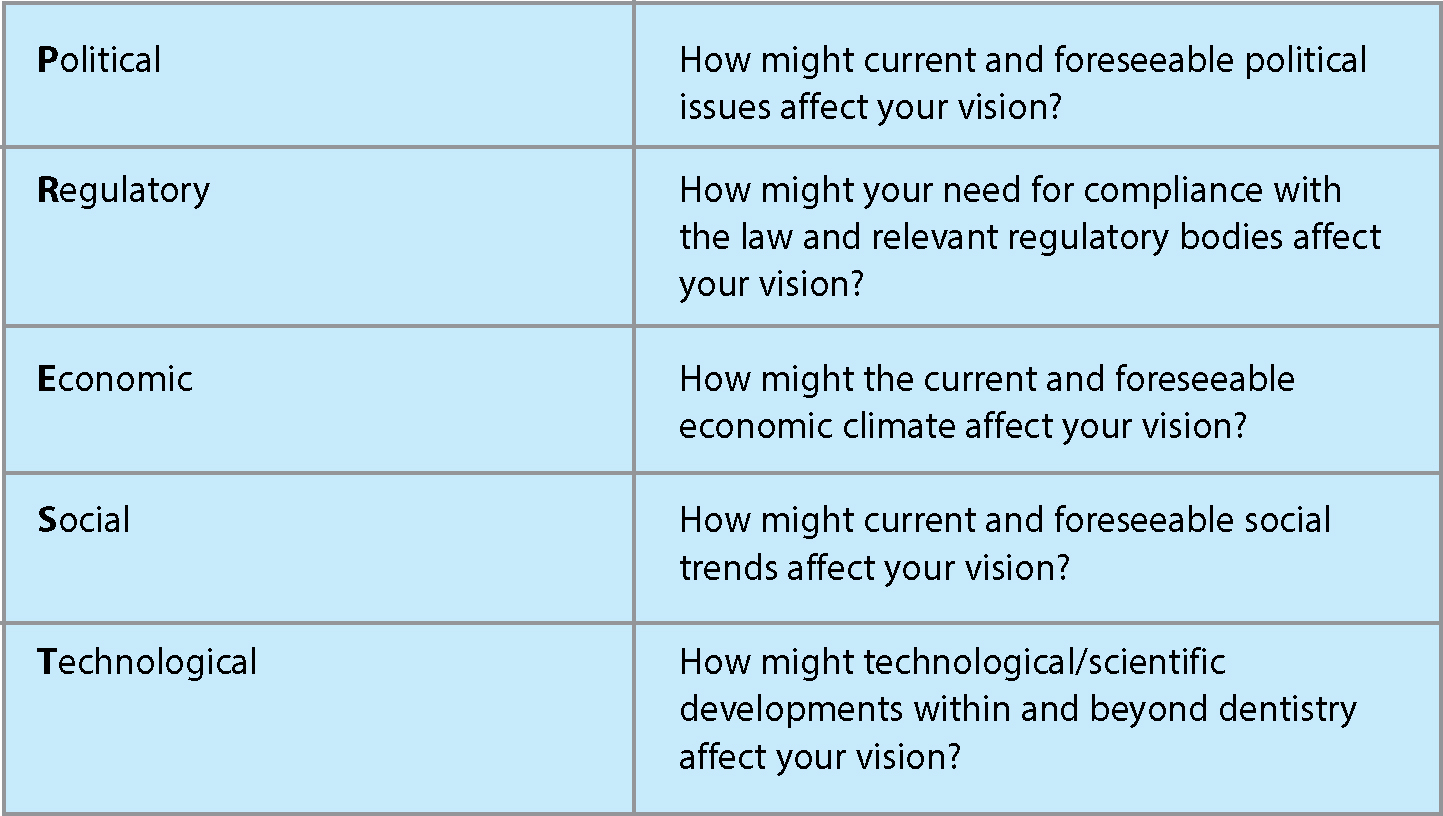Article

This series of four articles opens by discussing the concept of leadership and its importance in the fast changing world of dental practice. Styles of leadership are considered and the opportunity to develop your leadership skills is affirmed. Leadership is not something that you have to be born to; the art can be developed. Three pillars of leadership are proposed namely:
These articles aim to give the reader some straightforward ideas for developing leadership skills and a set of further reading references to help with further development.
Developing your practice Vision
Developing your practice Vision is about setting inspirational direction to bring success in the future. A Vision will need more uplifting language than a performance target! Once more it is easy to conclude that a leader with vision must be something of a magician with skills beyond mere mortals. Kotter in 1990 helps allay this misconception when he states:1
‘Visions and strategies do not have to be brilliantly innovative: in fact, some of the best are not. Effective business visions regularly have an almost mundane quality, usually consisting of ideas that are already well known.’
The key to an effective vision, Kotter suggests, is that it addresses the future interests of the key stakeholders: in the case of a dental practice, the patients, the practice team and the practice owner.
Emma De Vita in The Leadership Masterclass emphasizes the need for a vision to be ‘down to earth’ when she quotes a manager from a multinational company as saying:2
‘In this Company we don't have a vision we have a hallucination.’
Steve Ratcliffe emphasizes how we can all develop a vision based on our passions when he says:3
‘Leadership is not about your competencies, skills and personality. It's first and foremost about being in touch with what you care about and then going for it.’
Clearly, it would be of great benefit to your personal motivation if your practice vision was based on what you are most passionate about in dental practice. So the starting point in developing your vision is to identify what you care about.
Remember that developing a Vision is not the same as writing a business plan. It is not simply a long-term plan. Planning is an important logical management function designed to produce orderly results. The plan will include performance goals and targets but these alone are unlikely to inspire. As Kemp said, just imagine if Martin Luther King, in his famous ‘I have a dream’ speech had simply said:4
‘I want there to be two black judges on the Supreme Court by 1975.’
Your vision must be about your passions not simply about your key goals.
Whatever your dental passions are, however, your vision cannot ignore the realities of the world around us. As Steve Radcliffe states:3
‘The leader takes a couple of steps back and looks at the big picture, the context’
Heifitz and Linsky describe this ability to see what is going on in the world so that opportunities and risks can be identified as:5
‘Getting off the dance floor and going to the balcony’
This important leadership function has also been described as a ‘helicopter view’. There are therefore two important phases needed in order to develop your practice vision:
Identifying your passions
To do this properly we need to be relaxed and able to think freely. Tim Kemp (1994) in The Lonely Practice describes the rather extreme lengths that Blackfoot Indians went to, in order to reflect on their vision for life, and their position in the context of all of nature.4 They retired to ‘dream beds’ dug into the Canadian Prairie where they remained without food and drink in temperatures which could swing through 80°C until their vision was formed. Mercifully, Tim suggests that mere dentists might like to retire to a favourite, peaceful and relaxing setting, such as a riverside bench or a favourite corner of the garden. After taking five minutes to relax and really appreciate our surroundings, the time for self-questioning will have arrived. Tim suggests that the question should be: ‘How would I like my practice to be remembered?’
Radcliffe suggests:3
‘What do I care about?’ (in dental practice) You could simply try:
‘What would my ideal practice be like?’
Both Radcliffe and Kemp stress the need to take time over this and to avoid becoming distracted by your limiting beliefs such as:
Express your thoughts on paper in any way that you can understand them subsequently. At this stage, you are not looking for snappy mission statements and certainly not performance targets. To give some structure to your thoughts, enter them onto the grid reproduced in Figure 1. Simply list the ideas that you have developed into whichever box seems to be appropriate. You have one box for each of the dimensions of success described for dental practices by Busby in ‘The ‘Secret’ of Success’ series.6 This grid should therefore encourage you to reflect on all the aspects of your success which are relevant to dental practice. You should find that any idea which you develop fits into at least one of these domains. No examples of the aspirations and ideas which might be developed by you in any ‘box’ are given, because the whole point is that they must be your ideas.

Take a helicopter view
This second phase could be described as the strategic aspect of your vision because you are now attempting to develop your future pathway to success taking into account the world outside. This will be a somewhat more logical process than phase 1. However, care needs to be taken so that this phase maintains the inspirational quality of phase 1 and does not simply become a business plan (as important as these are to your practice management). As we have already established, the world outside is changing rapidly, and so this aspect of your vision needs regular review to maintain the right direction through time. Your passions could also evolve over time, and so even phase 1 must not be in tablets of stone!
Use the PREST analysis reproduced in Figure 2 to focus your thinking. This PREST analysis is a tool which can also be used annually to revise your business plans. When conducting a planning exercise, this tool is used to identify important threats and opportunities and then subsequently devising detailed plans for addressing them. The purpose of using the analysis in phase 2 of the development of your vision is to align your passions with a practical and down-to-earth approach to the real world (remember Kotter's advice).

Once you have completed this process, use the thoughts developed on your PREST analysis to modify the text on your vision grid. You can, if you wish, then attempt to construct a mission statement based on the ideas you have developed on the vision grid. However, avoid the trap of creating a trite statement which could engender more ridicule than inspiration. There is much to be said for retaining the whole grid as the text of your vision. Finally, it would be worth benchmarking your work against Emma De Vita's checklist below:2
The final point moves us neatly into the next pillar – motivation. Article 3 in the series will deal with this leadership pillar.
